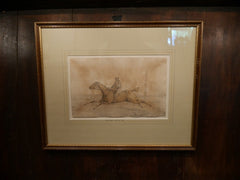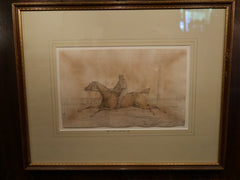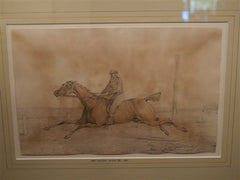









Pair of Henry Aiken Watercolor Original Paintings of Jumping Scenes in ombre shades of creams and sepia browns.
From about 1816 onwards Alken "produced an unending stream of paintings, drawings and engravings of every type of field and other sporting activity,"and his soft-ground etchings were often colored by hand. When Alken was 26, he and his young family lived over a shop in Haymarket that belonged to print publisher Thomas McLean of the "Repository of Wit and Humour." McLean paid Alken a daily wage of thirty shillings, considered a good income at the time.
Alken died in April 1851 and was buried in Highgate cemetery. Although fairly affluent for most of his career, he fell on hard times towards the end of his life and was buried at his daughter's expense.
Alken worked in both oil and watercolor and was a skilled etcher. His earliest productions were published anonymously under the signature of "Ben Tallyho", but in 1816 he issued The Beauties & Defects in the Figure of the Horse comparatively delineated under his own name. From this date until about 1831, he produced many sets of etchings of sporting subjects mostly coloured and sometimes humorous in character, the principal of which were: Humorous Specimens of Riding 1821, Symptoms of being amazed 1822, Symptoms of being amused 1822, Flowers from Nature1823, A Touch at the Fine Arts 1824, and Ideas 1830. Besides these he published a series of books: Illustrations for Landscape Scenery and Scraps from the Sketch Book of Henry Alken in 1823, New Sketch Book in 1824, Sporting Scrap Book and Shakespeare's Seven Ages in 1827, Sporting Sketches and in 1831 Illustrations to Popular Songs and Illustrations of Don Quixote, the latter engraved by John Christian Zeitter.
Alken provided the plates picturing hunting, coaching, racing and steeplechasing for The National Sports of Great Britain(London, 1821). Alken, known as an avid sportsman,is best remembered for his hunting prints, many of which he engraved himself until the late 1830s. (Charles Lane British Racing Prints pp. 75–76). He created prints for the leading sporting printsellers such as S. and J. Fuller, Thomas McLean, and Rudolph Ackermann, and often collaborated with his friend the sporting journalist Charles James Apperley (1779–1843), also known as Nimrod. Nimrod's Life of a Sportsman, with 32 etchings by Alken, was published by Ackermann in 1842. In many of his etchings, Alken explored the comic side of riding and satirized the foibles of aristocrats, much in the tradition of other early 19th century caricaturists such as Thomas Rowlandson and James Gillray. One of his best known paintings, "The Belvoir Hunt: Jumping Into And Out Of A Lane", hangs in the Tate Britain and shows one of the oldest of the great foxhound packs in Leicestershire.A collection of his illustrations can be seen in the print department of the British Museum.